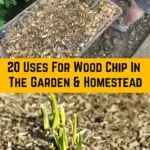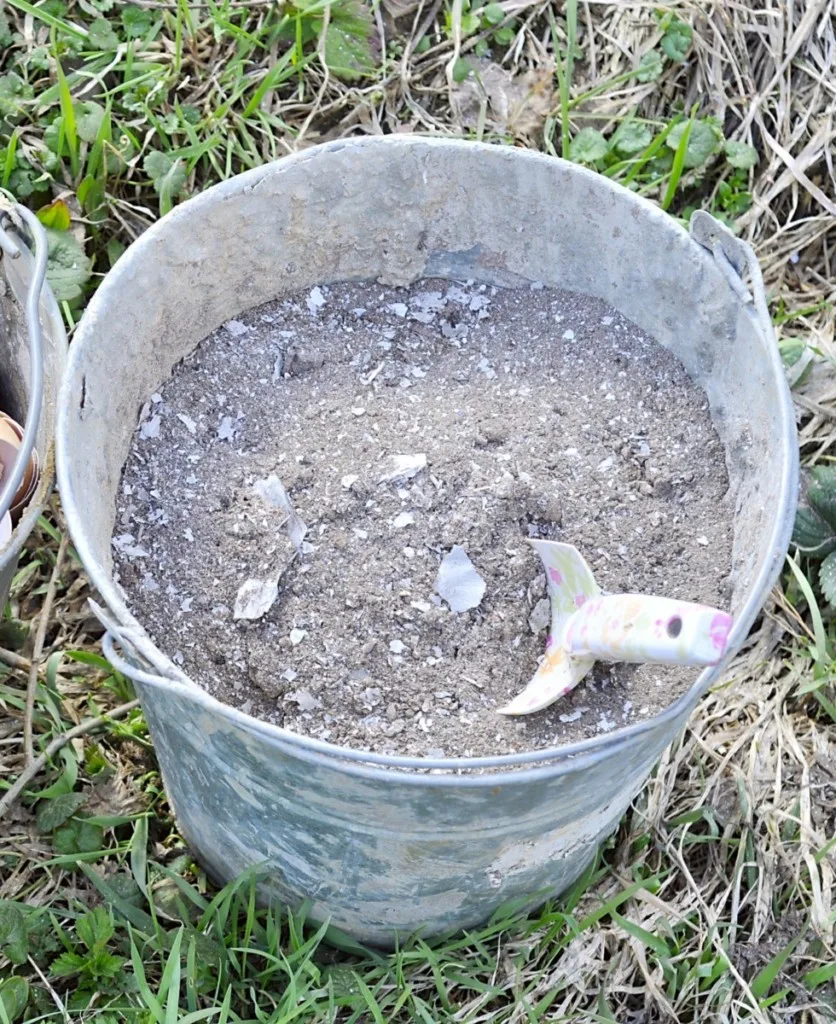
Wood chip is a material that many take for granted. It is common on many homesteads, and used in many gardens, parks and public spaces.
It is a valuable material, that can be put to many different uses.
But there is a lot of confusion out there about what is should and should not be used for. And there is a lot of misinformation out there.
In this article, we’ll look at 20 useful ways to use wood chip around your homestead.
Not All Wood Chip Is Created Equal
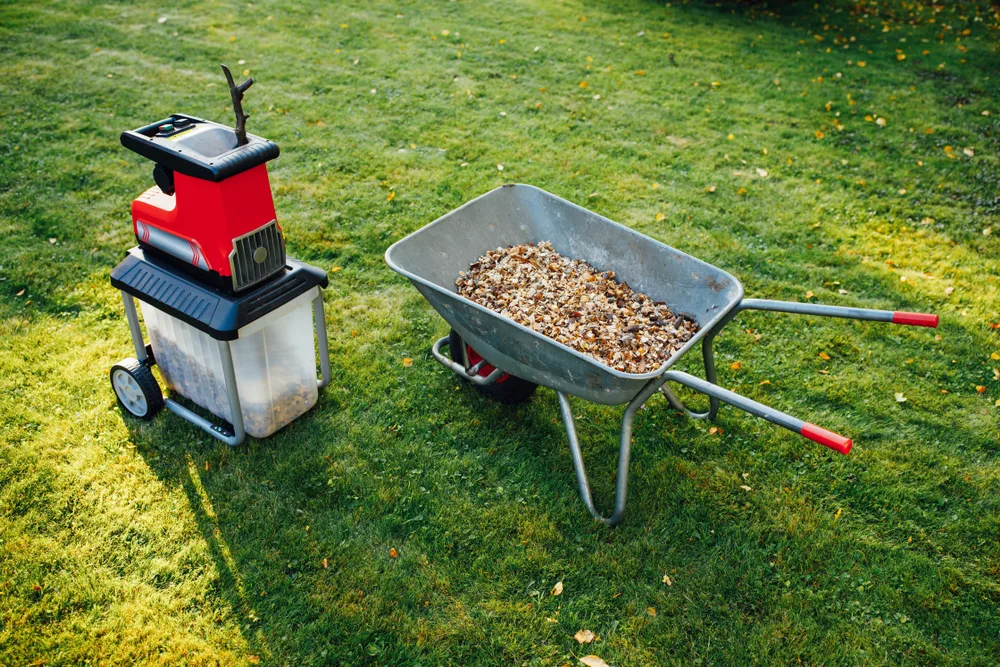
Before we get to that, however, it is important to mention that not all wood chip was created equal. Wood chip can come in different grades, or sizes, and can be made from a range of different types of wood.
Which wood has been chipped will have a large bearing on how useful it will be and where it can be used.
Another thing to mention is that not all wood chip is quite as natural and eco-friendly as you might imagine.
If you purchase or source wood chip from somewhere other than your own homestead, it is important to ascertain exactly where it came from and whether or not it has been treated.
It will also be important to know which type or types of wood were used.
Personally, I would highly recommend getting an electric chipper for your homestead. If you run it with renewable energy, using one can be an eco-friendly choice.
And being able to make use of small branches and twiggy material by turning it into wood chip on your property can be extremely useful.
1. Use Wood Chip as a Mulch
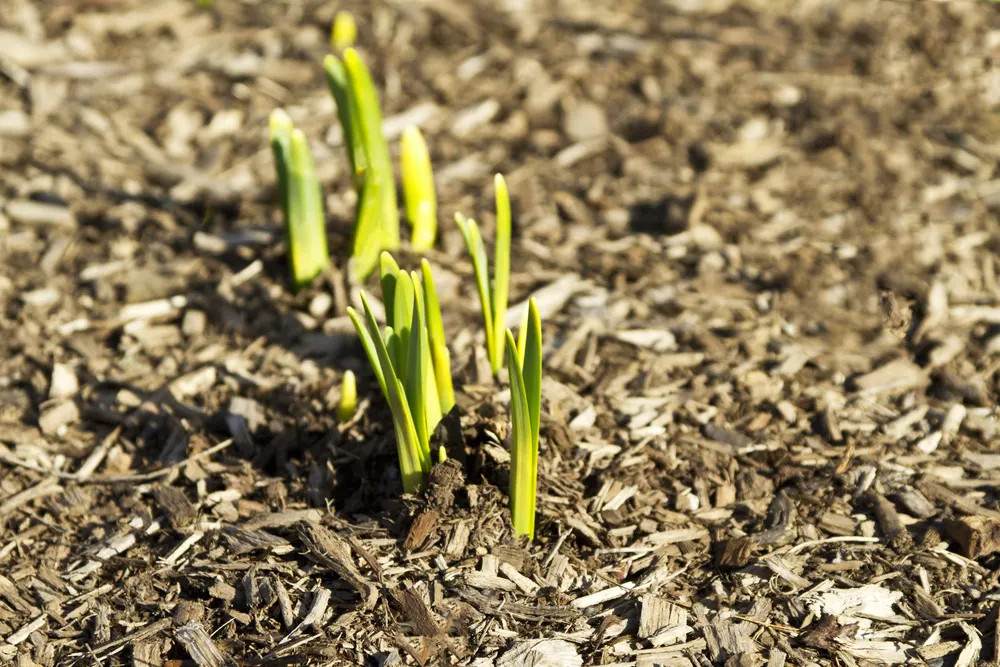
The first and most obvious way to use wood chip on your property is to use it as a mulch in your garden or in your growing areas.
But using wood chip as a mulch is not necessarily as straightforward a proposition as it may at first appear. There is a certain level of complexity regarding where you should and should not use it.
To synthesize things a little, you can and should use wood chip as a mulch with little concern:
- Around fruit trees and mature shrubs, especially in a forest garden.
- Around mature woody perennials in ornamental beds or borders.
- In wild woodland areas or around mature ornamental trees.
But if you are considering using wood chip as a mulch in your vegetable garden – things are not quite so simple.
Generally speaking, it is not a good idea to use fresh wood chip around annual crops. Nor should you grow annual fruits and vegetables in an area where fresh wood chip has sat.
But that does not mean that you cannot use wood chip in your vegetable plot at all.
You can learn more about this, and get some tips for using wood chip as a mulch, below.
Tips For Using Wood Chip as Mulch
As mentioned above, wood chip comes in different sizes. First of all, when considering whether or not to use it as a mulch, it is important to think about which size you have.
As a general rule, the larger the pieces of wood, the longer they will take to break down.
Another thing that will make a difference is whether it was dried or partially dried harvested wood that was chipped, or sappy green wood, along with some green leafy material, from your garden.
Fresh Wood Chips Tie Up Soil Nitrogen as They Decompose
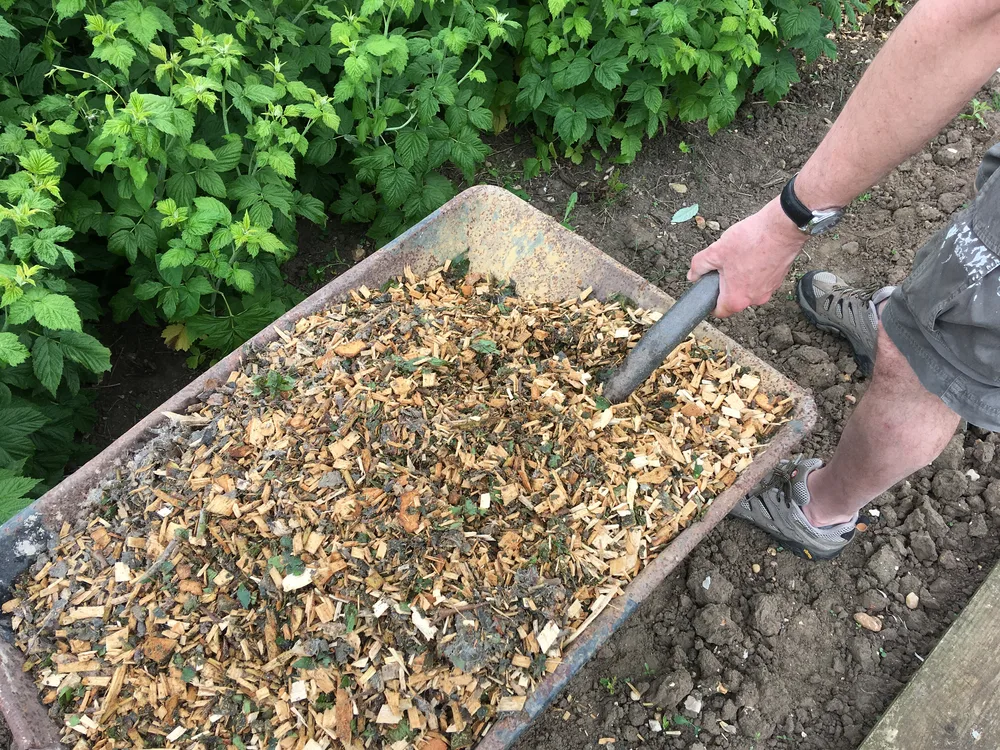
The reason why there is so much debate over the use of wood chip as a mulch largely revolves around this issue.
Wood chips are low in nitrogen. So the microorganisms that utilize the low-nitrogen organic matter as food (decaying it) must obtain the nitrogen they need from somewhere else.
They take it, where no other nitrogen source is available, from the surrounding soil.
Once they die, the nitrogen is returned to the soil, and made available to plants once more. But in the short term, there may not be enough nitrogen available for plants.
When the wood chip is placed on top of the soil, it interacts only with the upper soil surface and will not affect nitrogen levels available lower down in the bed.
But it is not a good idea to mulch seedlings and annual plants with just fresh wood chip in part because many require plenty of nitrogen during the time that the wood chip is breaking down.
And with less root spread, and in a bacterial rather than fungal environment, they are less likely to be able to obtain it from elsewhere.
Solutions:
However, you could consider adding wood chip as a mulch, even around vegetables, if you add a nitrogen-rich mulch material at the same time.
That way, there will still be plenty of nitrogen to go round even while the decomposition is taking place.
Green wood that you have chipped yourself along with some green leafy material will already have this nitrogen source built in.
If using a lower nitrogen wood chip, grass clippings, green leaves or a nitrogen-rich liquid feed will do the trick.
Another option is simply to compost the wood chip before you use it as a mulch (see idea number 4). That way, decomposition has already taken place and nitrogen tie-up is not an issue.
Partially Rotted Wood Chips Are Different To Fresh Chips
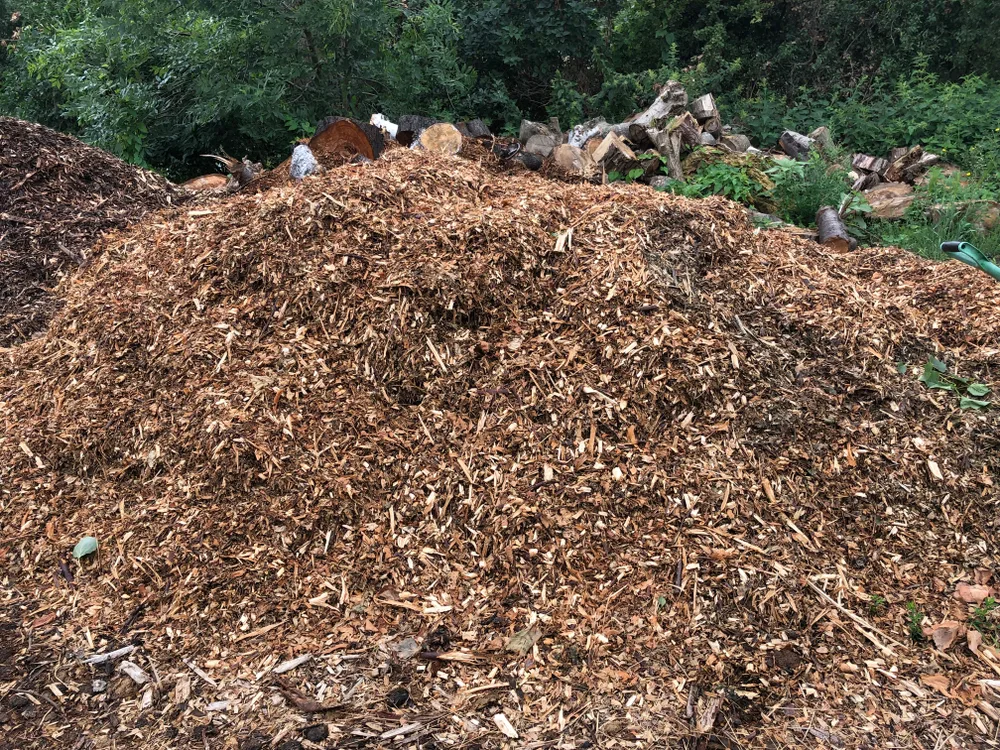
Even if you do not add wood chips to your compost heap, you can simply leave them in a corner of your property to begin decomposition. That way, as mentioned, nitrogen tie-up will not be an issue.
Another option would be to use them in one of the other ways mentioned in the list below and then, once they begin to break down, spreading them as mulch.
Wood Chips Create a Fungal Rather Than Bacterial Environment
One reason that wood chip can be great for forest gardens or woodland environments is that it helps to nurture a fungal environment.
A fungal environment is like that of a natural woodland or forest.
Orchard trees and other trees and woodland/forest plants thrive in soil with a fungi-bacteria ratio of 10:1 – 50:1.
In areas where annual grains and vegetables are grown, the fungal/bacterial ratio is generally around 0:3 to 1:1.
Too high fungi counts in a vegetable garden can actually be detrimental over time – which is another reason why wood chips are better used in other garden areas.
It Matters Which Trees Have Been Chipped
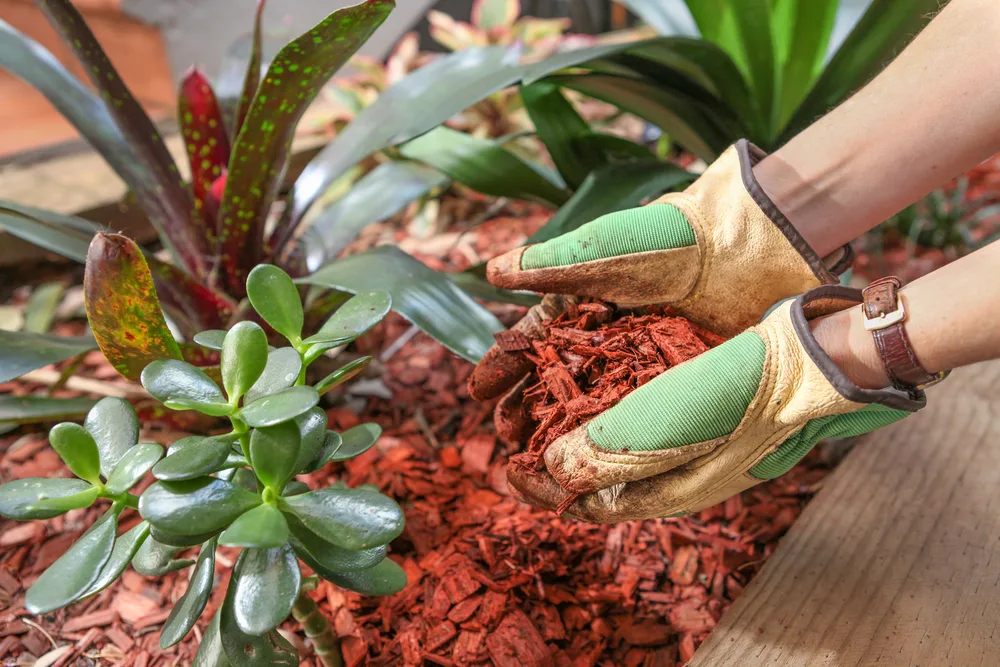
This is another important thing to bear in mind if you plan to use wood chip as mulch. (In fact, it is also an important issue for a number of the uses described below.)
Hardwood wood chip will have different properties to that made from a softwood like pine.
If using a conifer, for example, it is important to note that it can acidify the soil. This could be beneficial for areas with alkaline soil – but may be undesirable where ericaceous soil is found.
Look Out For Allelopathy
One final thing to mention is that certain woods, such as walnut, contain juglone – a biochemical that retards the growth of nearby plants.
This phenomenon is known as allelopathy.
Be careful not to use walnut wood chip around plants that might be affected by this retardation.
2. Use Wood Chip To Build Up Raised Beds
As mentioned above, you will likely not wish to use fresh wood chips as a mulch for annual growing areas. But you may wish to use some to create new growing areas (especially if it has already been partially rotted).
Wood chips can be great for building up raised beds using the lasagna bed process.
As a bulky, carbon rich material, that is often readily available in fairly large quantities, it could be an ideal choice for new, low cost growing areas.
When creating a lasagna bed, what you are basically doing is composting in place. As in a compost heap, relatively thin layers of ‘brown’ carbon rich and ‘green’ nitrogen rich materials are built up.
Wood chip of various varieties fits into the ‘brown’ category. It can therefore be a good choice of material to begin filling your raised beds.
3. Use Wood Chip in a Hugelkultur Mound
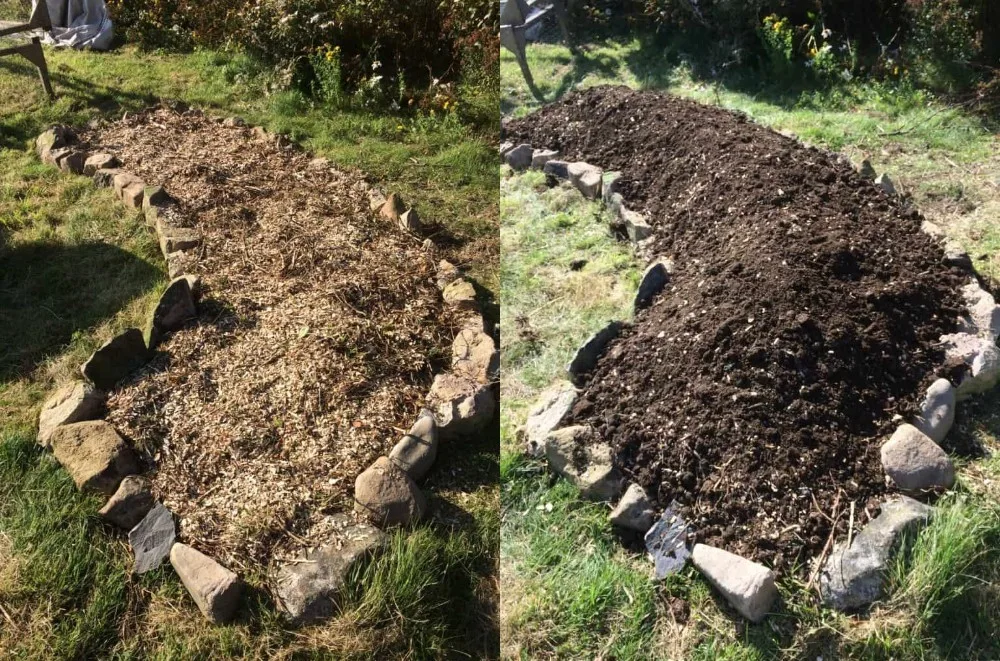
A related but somewhat distinct idea is to make new growing areas for your homestead using the hugelkultur (mound culture) technique. As in lasagna gardening, the idea is to compost brown and green materials in place.
But rather than making a flat raised bed, in hugelkultur you will make a mound shape.
Take a look at our step-by-step tutorial for building a hugelkultur raised bed here.
At the heart of the mound will be partially rotted wood, which will form the ‘skeleton’. Onto this skeleton, you can add your layers, as above.
Again, wood chip can be a useful ingredient amongst the others used to make a growing area of this kind.
4. Add Wood Chip To Your Compost Heap
You might not be creating new growing areas. And you might not have the space to create a separate heap to allow partial decomposition of the wood chip.
In such instances, adding wood chip to your compost heap could be a perfectly viable solution.
Note, however, that if the wood chip has larger pieces, decomposition will take longer and your compost may not be as fine.
It is also important to remember that, as with other compostable materials, wood chip should only be added a little at a time.
You must not add too much ‘brown’ or too much ‘green’ at one time. The heap (or bin) must be kept balanced.
5. Use Wood Chip in a Hot Bed
Wood chip, like other compostable materials, will give off a certain amount of heat as it breaks down. As in the examples of other growing areas mentioned above, you can also use wood chip to make a hot bed.
When making my own hot bed, I used:
- chicken manure, from the coop where we keep our 15 rescue hens,
- partially composted chicken manure & bedding (from the top of the compost heap near the coop).
- along with the wood shavings that are used in their nesting boxes.
- I also used other materials that I had on hand – further wood chips that were shredded prunings from the forest garden, and some dried leaves.
I added these materials in thin layers, which helps to aid decomposition.
The heat is retained with walls with good thermal mass, and a recycled glass cover.
6. Use Wood Chip as a Path Material
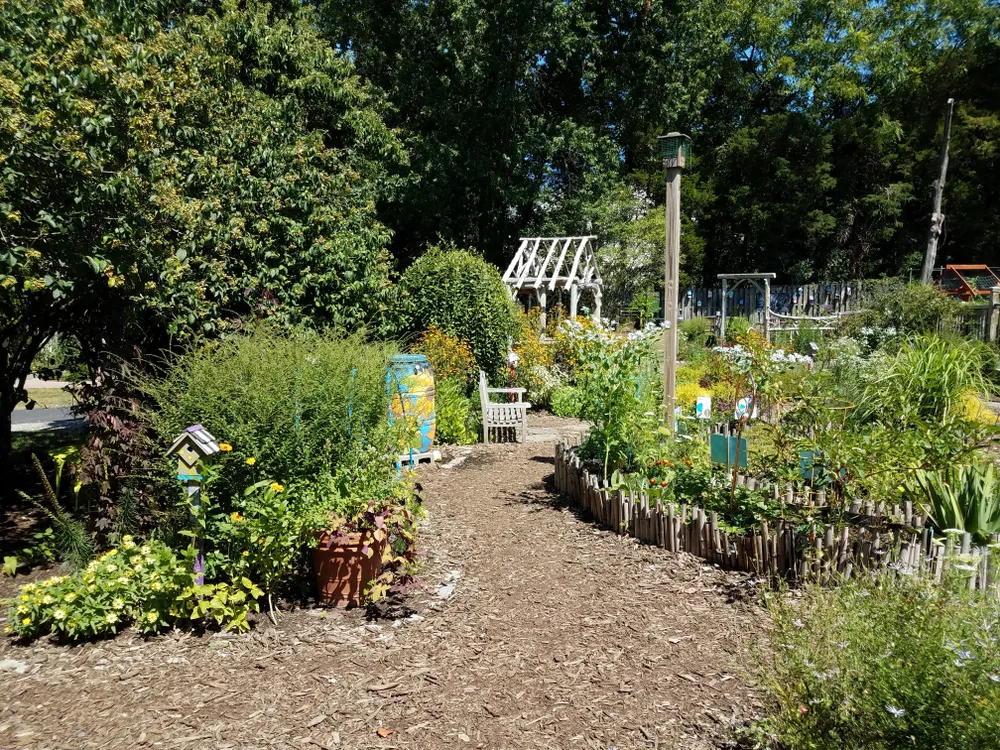
One of the main ways that I use wood chip around my forest garden is as a material to make informal paths. I use a fairly finely shredded mix from our electric shredder.
This means that the material breaks down fairly quickly. The paths, therefore, are far from permanent.
But when they are wearing thin, I scoop up the broken down woodchip/ humus material and scatter it around my plants nearby. I then replenish the pathway with a new batch of woodchip.
Allowing the material to break down on the paths kills two birds with one stone.
It means I do not need a separate space to break down the material. And it provides easy access to the forest garden. What is more, the mulch material is right there where I need it.
7. Spread Wood Chip In Your Chicken Run
If you have a permanent chicken run, wood chip makes an excellent material to spread out on the ground.
Note, however, that you should only use hardwood wood chips for this purpose, and not bark chip, pine, or other inferior products.
Bark can go moldy and can give off spores that may cause respiratory illness in your hens. It also breaks down much more quickly.
Pine and other softwoods can splinter, with risk of bumblefoot. Some woods emit volatile oils that can be bad for your flock. If you are buying your wood chip, make sure it is untreated.
Lay hardwood chips to a depth of around 5cm on permanent run areas, to prevent the area from becoming muddy and to give the chickens something to scratch around in.
Add fall leaves and plenty of other organic material and you can create a compost over time.
When it is time to refresh it, simply scrape it all out and add it around your trees and shrubs, then add more organic material to the run.
8. Use Wood Chips As Livestock Bedding
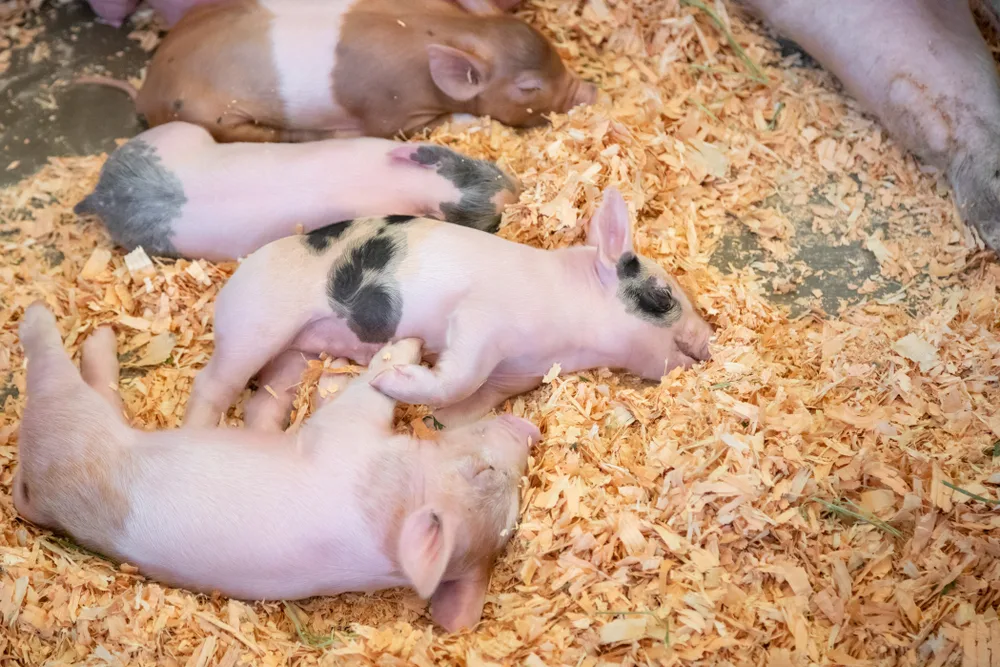
Research has also suggested that wood chip can be used as an economical alternative to straw bedding for cattle and certain other livestock. If the price of straw is high in your area this could be a viable alternative.
Wood chip produces little to no dust and allows livestock to stay clean. The moisture content should be around 20% for optimal results.
Be sure to check particle size and consult experts, however, and not to choose wood chip with any sharp objects or chemicals.
Seek appropriate advice to make sure you make the right choice for your wood chip livestock bedding.
9. Spread Wood Chip Around a Kids’ Play Area
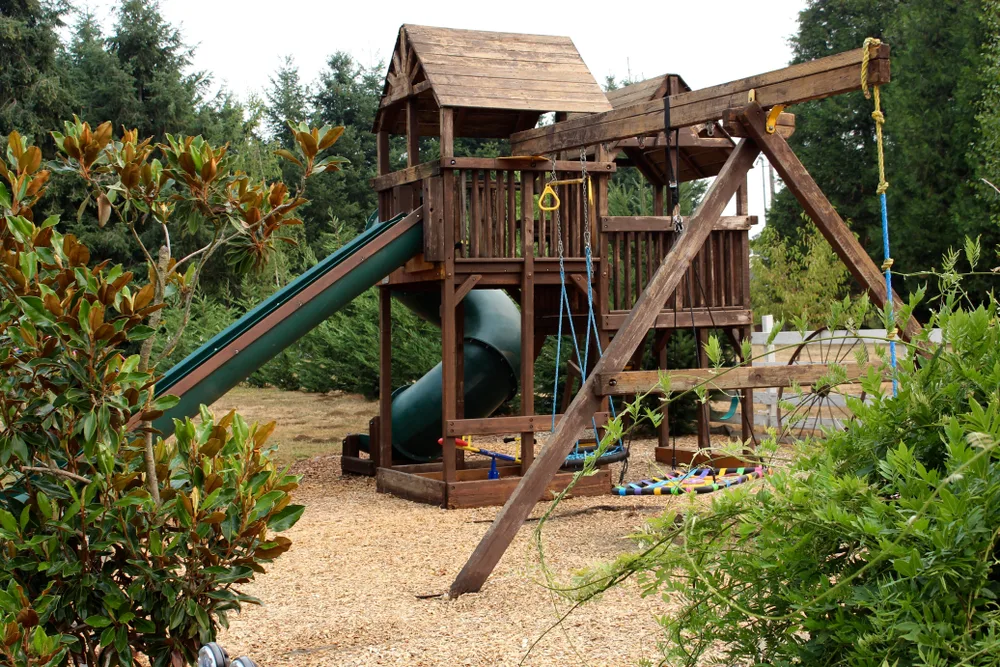
Another good way to use wood chip of a range of different kinds is to cover the ground around a kids’ play area.
Wood chip can be used to provide a cushioned landing below swing sets and jungle gyms, for example. It can provide a level yet relatively soft surface, and prevent the degradation of the ground beneath.
It can stop an area of heavy traffic from turning into a muddy quagmire.
10. Spread Wood Chip to Create an Informal Garden Seating Area
You can also spread a range of different types of wood chip on the ground in your garden to create an informal seating area. This can be a great way to avoid mud-baths around benches or other garden seating.
The benefit of using bark is that you will not have to go to the time and expense of creating a hard, permanent patio or paved area.
To prevent the wood chip from spreading out onto a lawn or surrounding growing areas, you may wish to contain the material with some eco-friendly garden bed edging.
Depending on what type of wood chip you have chosen, you may also be able to use partially decomposed material from the area in one of the other ways described above.
Removing the partially broken down material and adding new will keep the area looking good.
11. Set Up a Compost Toilet System
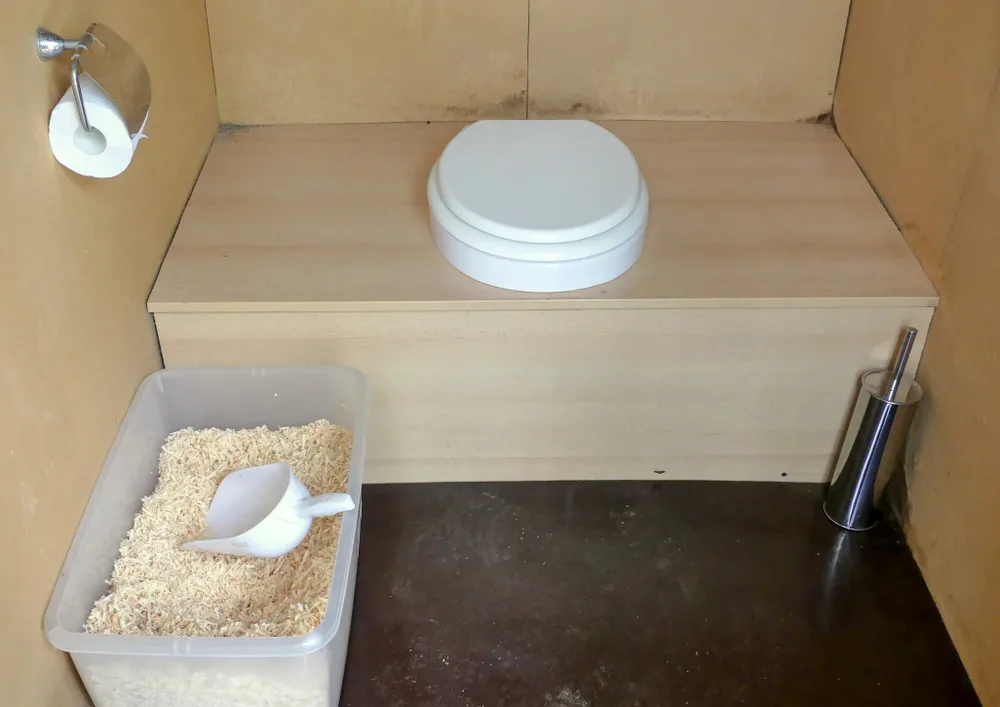
Another, more unusual way to use partially decomposed wood chips is in a compost toilet system. Bucket toilets are an interesting and eco-friendly alternative to a traditional flushing lavatory system.
‘Humanure’ composting is a fascinating area. Composting human ‘manure’ could be an interesting way to move even closer to a truly ‘zero waste’ way of life.
In a bucket toilet, after you have ‘been’, you will cover over the waste with carbon rich material.
Often, sawdust is used. But partially composted wood chip has also been found to be a good alternative.
Even if you do not have such a system in your home, you might find a place for a compost toilet somewhere else on your homestead.
Bucket Toilets @ diyhousebuilding.com.
12. Use Wood Chips in a Bug Hotel
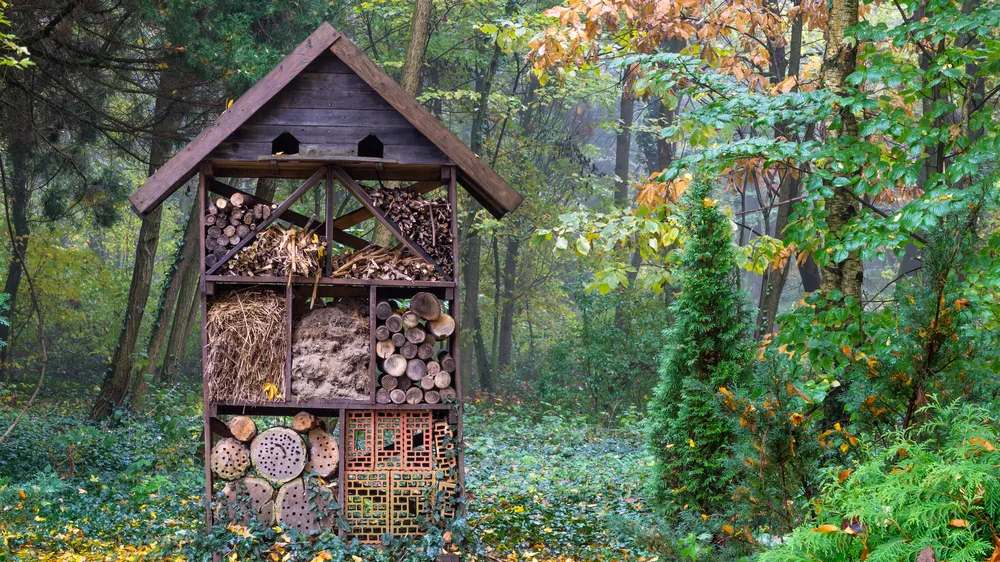
Small quantities of wood chips may also come in handy as a material for building habitat and creating a ‘bug hotel’ or ‘insect hotel’ in your garden.
Creating one of these homes for invertebrates and other wildlife is a great way to promote and encourage biodiversity.
You can use a wide range of different natural and repurposed ‘found’ materials to make one of these structures. And wood chips you have chipped on your property could be one great ingredient to include.
How to Build an Insect Hotel @ theedenproject.com
13. Use Wood Chips in a Compost-Powered Water Heating System
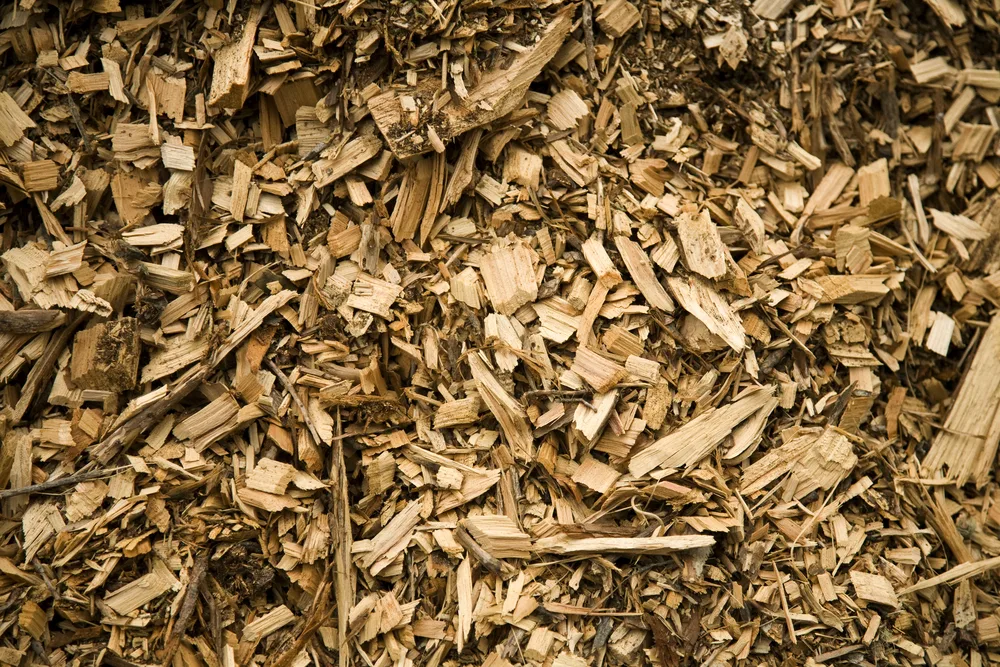
If you are composting wood chips on your property to use in your growing areas, why not take advantage of the heat they give off when they break down?
Smaller wood chips are great as the carbon element in the heap, added in equal quantities with nitrogen rich materials.
Larger wood chips can also be used to cover the heap (as an alternative to straw) to help retain the heat that is given off.
To gather the heat that is given off by decomposition, a hose is coiled through a large heap. It is connected to an outside spigot (or rainwater harvesting system) and filled with water.
The water will be heated within the pipe coiled in the heap. You could then potentially use that water for your outside kitchen, for an outside shower, or even an outside tub.
How To Make an Outside Water Heater With Compost @ onegreenplanet.org.
14. Use Wood Chip as a Substrate To Grow Mushrooms at Home
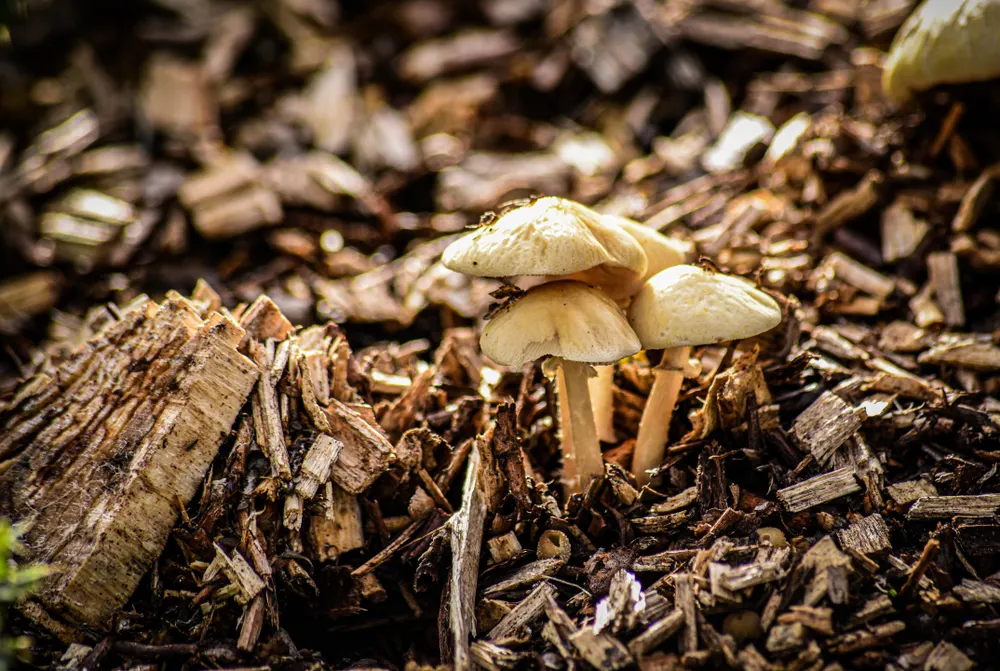
You may wish to branch out from growing fruit, vegetables and herbs. If so, mushroom growing could be something interesting to consider.
Different mushrooms will grow best on different substrates and in different ways. Oyster mushrooms, for example, can be grown on sawdust, coffee grounds, or even old books.
They can also grow well on mushroom logs, as can shiitake mushrooms.
Wine caps are one example of a type of mushroom that can be grown in piles of wood chip.
Making a Wood Chip Mushroom Garden @ milkwood.net.
15. Make Your Own Rustic Paper
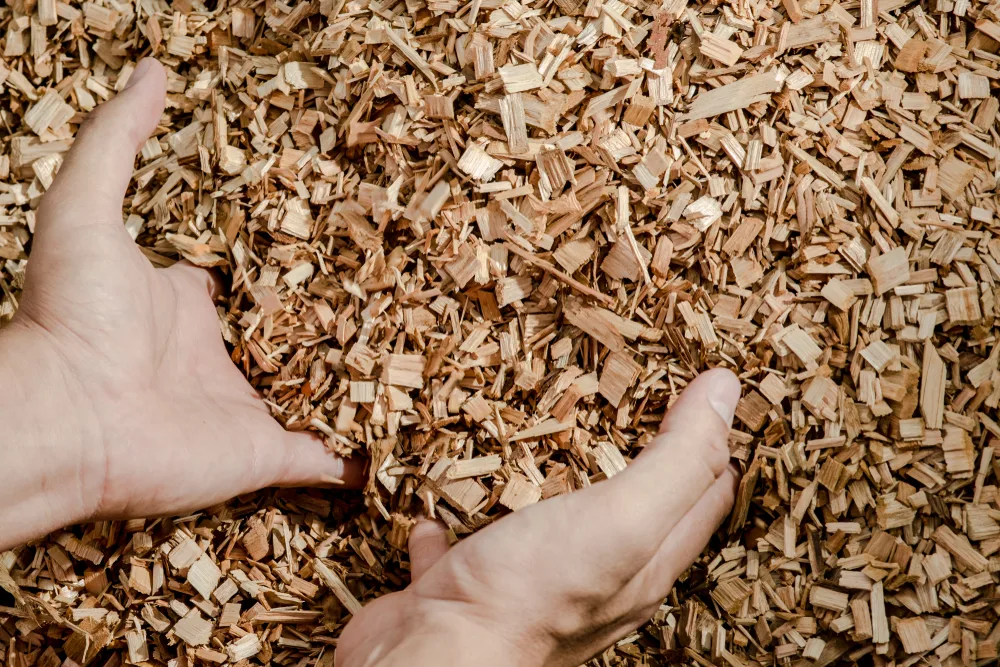
If you feel like taking on a new, challenging craft project, you could also consider breaking up smaller wood chips into wood pulp, and using it to make your own rustic paper at home.
Of course, wood pulp is used commercially to make paper. But by making you own you can move towards a more sustainable way of life.
You can make sure that you are not contributing to the destruction of forests.
It has to be said that making your own wood pulp is not an easy process. The wood needs to be broken down, using heat and mechanical means, or chemicals.
It is far easier to use other plant fibres, or recycled paper, to make your own paper at home.
But if you want to experiment, you may find a way to use wood chip/ shavings/ sawdust for the purpose.
16. Make Wood Chip and Natural Beeswax Fire Starters
In order to store carbon, rather than releasing it, it is generally best to use wood chip in your garden, rather than burning it.
But wood can be an incredibly useful and eco-friendly fuel in a range of situations. It can offer a more sustainable alternative to other fuel types.
If you have a wood burning stove on your property, wood chips from your garden shredder can be used to make natural beeswax fire starters.
17. Use Wood Chips as Fuel in a Small Stove
Wood chips may not work well on a traditional wood burning stove. But small camping stoves such as the Biolite stove are designed to be fuelled by wood chips, small sticks and twigs, and other small fuel sources.
For camping or for outdoors cooking in your garden, these can be an excellent option and are far more efficient than a traditional open fire in a fire pit.
They can also be used to charge up your phone or other small devices.
18. Make Your Own DIY Wood Briquettes

If you do want to use wood chip as fuel in a solid-fuel stove or solid-fuel boiler, placing them loose into the fire box is generally not the best idea.
But you might want to consider forming them into your own DIY wood briquettes.
These tightly compacted blocks are usually bought in from stores. But the video below shows how to make a DIY briquette press:
And here is some more information about making your own:
Homemade Briquettes and Logs @ naturalbuildingblog.com.
19. Make Your Own Charcoal or Biochar
You can also use wood chips in a pit, a clay charcoal oven or a retort (made with old metal barrels) to make your own charcoal.
The charcoal could, of course, be used on your barbecues. But you could also consider using this charcoal to make biochar.
Check out the link below for more information on one potential process using wood chippings.
Intuitive Biochar @ biochar-international.org.
20. Use Wood Chip in a DIY Smoker or Barbecue Grill
Finally, if you do like to barbecue or have an outdoors smoker, you can also use certain types of wood chip to impart different smokey flavors to your food.
Different types of wood can be used to impart different flavors. Check out the wood flavor chart at the link below for ideas:
Smoking Woods @ weber.com.
No matter what kind of wood chip you have access to, you are sure to find some use for it on your homestead.
Read Next:

Get the famous Rural Sprout newsletter delivered to your inbox.
Including Sunday musings from our editor, Tracey, as well as “What’s Up Wednesday” our roundup of what’s in season and new article updates and alerts.


